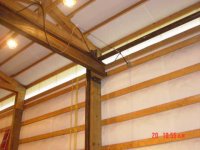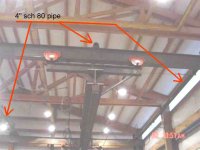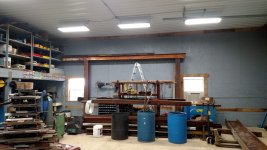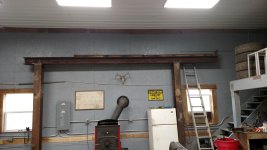LD1
Epic Contributor
I am no pro at any of this. But I am not concerned.
I will rate the W18x60 beam over the 37' span for 5k max load.
That is WELL under the failure point of the beam. I assigned this value based on many many crane beam span tables I have looked at.
Assuming 36ksi yeild steel (A36) which is the weakest beam because most are actually A992 (50ksi), A 5:1 Safety factor based on stress is 7013lbs.
And the plating is not right in the middle either. The spliced pieces were 13 and 25', so that puts it in a lower stress area.
I figured the plating wasnt even necessary. Everything was beveled all the way through and welded with 100% penetration. I just figured the plating wouldnt hurt and I had the material anyway.
Shieldarc:
The truck beams are 20' long and going to set on columns 15' apart. The columns are W10x33 beams with a 12x12x1/2" plate and (4) 3/4" anchors to the floor. On top is a 8x"x10"x1/2" plate welded. The truck beams are going to sit on top and be welded all the way around.
The truck beams are slightly different sizes. One is a W8x24 and the other is a W8x31. Same height though and both strong enough for the span.
Then there will be knee braces going from the column to the truck beam. Havent decided yet if I will add a few braces to tie into the wall or not. The columns are 10' high and feel pretty darn solid.
I will rate the W18x60 beam over the 37' span for 5k max load.
That is WELL under the failure point of the beam. I assigned this value based on many many crane beam span tables I have looked at.
Assuming 36ksi yeild steel (A36) which is the weakest beam because most are actually A992 (50ksi), A 5:1 Safety factor based on stress is 7013lbs.
And the plating is not right in the middle either. The spliced pieces were 13 and 25', so that puts it in a lower stress area.
I figured the plating wasnt even necessary. Everything was beveled all the way through and welded with 100% penetration. I just figured the plating wouldnt hurt and I had the material anyway.
Shieldarc:
The truck beams are 20' long and going to set on columns 15' apart. The columns are W10x33 beams with a 12x12x1/2" plate and (4) 3/4" anchors to the floor. On top is a 8x"x10"x1/2" plate welded. The truck beams are going to sit on top and be welded all the way around.
The truck beams are slightly different sizes. One is a W8x24 and the other is a W8x31. Same height though and both strong enough for the span.
Then there will be knee braces going from the column to the truck beam. Havent decided yet if I will add a few braces to tie into the wall or not. The columns are 10' high and feel pretty darn solid.



